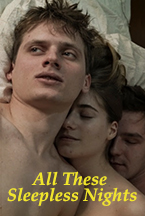ALL THESE SLEEPLESS NIGHTS

(The 2016 Sundance Film Festival is in full swing and we have boots on the ground as well as eyes on screener links for the whole festival! Stay tuned to Hammer to Nail as reviews start rolling in…)
Let’s start with what works. Polish director Michal Marczak (F*ck for Forest) has assembled a brilliantly photographed and masterfully edited collection of anecdotes about a young man’s post-university coming of age. It’s a year in the life of the protagonist that follows him through cigarette after cigarette, drink after drink, drug after drug, flirtation after flirtation. Featuring strong performances from lead Krzysztof Baginski and his best friend, Michal Huszcza, the movie is a portrait of life adrift in a Warsaw that’s left the Cold War far beyond (indeed, it ended before these folks were even born), where all is permitted. We’re on a journey towards maturity, but first we must navigate the perils of excess.
Did I say performances? That’s strange, as this film is categorized as a documentary: the “actors” play themselves. Well, yes, so they say, but this doesn’t feel like any documentary you have previously seen. Many of its scenes are shot from multiple angles, providing traditional (in fiction filmmaking) coverage; there is voiceover; there are sudden cuts from location to location, and from day to day, following the thought patterns of Krzysztof; there are moments – particularly ones of physical and emotional intimacy – that, strong as they are, feel stage-managed. For sure, hybridity has always been a part of the documentary experience (and is a frequent topic among academics). In the 1890s, both the Lumière brothers and Thomas Edison staged many of their early short films. In his 1922 seminal Nanook of the North – considered the first documentary feature film – Robert Flaherty asked his main “Eskimo” actor (not actually named “Nanook”) to perform scenes that he wanted to capture for the camera. So right from the beginning, the boundary of the real – or, the “real” – and the crafted was not as sharp as we might think. Still, this entire movie feels like a reenactment, even if it is, in fact, supposed to represent Krzysztof’s actual experiences. It’s a little unsettling, to be honest. Which is, actually, another source of the film’s strength.
What is less successful is the choice of actual subject matter. Ultimately, the content is far less interesting than the aesthetic. To watch young people chain-smoke, drink and drug is to see the banal: there is nothing new in that representation of disaffection. As Krzysztof spends yet another night in an inebriated haze, hashing out the same pseudo-philosophical topics that every other twenty-something has, at some point, addressed, it’s hard no to feel let down. But then we jump to a new scene, and marvel at the choreography of the camera, and all is good again.
I was particularly impressed – despite my frequent disappointments – with the urgency of some of the scenes. As Krzysztof and Michal make their way through a train tunnel and touch a passing train as it rushes by, we realize we are really there, and he could really lose an arm. At other times, we see Krzysztof dancing through traffic (my favorite visual metaphor of the film: the perils of youthful experimentation), and that does not, in fact, feel staged. I also love the opening image – to which we return halfway through – of fireworks over Warsaw. It’s a beautiful sequence, promising a cinematic experience that, when it is realized, is magical. It’s just too bad that so often we come down from these heights to a pedestrian “reality.”
– Christopher Llewellyn Reed (@ChrisReedFilm)












